What was Beeching's worst railway cut?
- Published
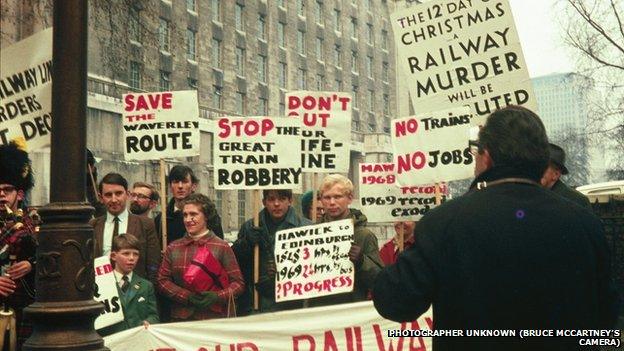
Waverley Route protesters muster prior to the three-person delegation proceeding to 10 Downing Street
It is 50 years since Dr Richard Beeching's report on British Railways which led to hundreds of stations and 650 miles of railway line being closed in Scotland.
The axing of the 98-mile Waverley Route from Edinburgh to Carlisle was the worst of all the Beeching cuts, according to author and railway expert David Spaven.
The closure left the Scottish Borders as the only region of Britain without a train service and Hawick, 56 miles from Edinburgh and 42 miles from Carlisle, as the largest town farthest from a railway station.
Dr Beeching was tasked with making the railways profitable again
Using criteria such as the length of line closed, the population of the affected towns and their distance from the rail network, Mr Spaven analysed 15 significant British lines which were lost in the Beeching restructuring.
He concludes that three of the 10 worst closures were in Scotland.
In addition to the Waverley Route, Mr Spaven says the 73-mile Dumfries-Stranraer line and the 43-mile Aberdeen-Fraserburgh route were among the biggest cuts.
He also highlights the Perth-Kinnaber junction (near Montrose) line closure, which left towns such as Coupar Angus and Forfar cut off from the network.
Mr Spaven, who has written a book called Waverley Route: the life, death and rebirth, external, insists his longstanding interest in the line did not influence his decision to choose it as the worst Beeching cut.

Riccarton Junction was a village of 37 houses created for railway workers between Hawick and Newcastleton
He says: "I think at a very basic level what made the Waverley Line closure such a bad one was the fact it was such a big long chunk of line.
"Towns of the size of Galashiels - which has a population of 13,000 - and Hawick which had a population of 16,000 - ended up further from the rail network than any other towns of their size in Britain. It was a shocker."
Borders railway campaigner Bill Jamieson says: "Hawick became very isolated. Once the Waverley Route closed it was nearly 50 miles from the nearest railway station."
He says that it used to be possible to get from Galashiels to Edinburgh in 50 minutes by train but now it takes about an hour and 20 minutes by bus and the quality of the journey is much lower.
It took six years from the Beeching recommendations to the actual closure of the Waverley Route in January 1969.
The protest against the closure provoked sabotage attacks and night-time blockades by furious locals.
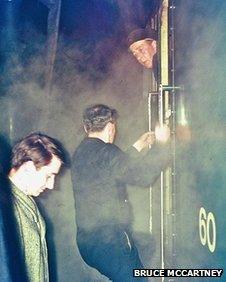
David Steel MP looks on as the signalman tells the driver he can proceed on the last journey
David Steel, now Lord Steel of Aikwood, was just 26 when he was elected to parliament in a by-election in 1965 called after the previous Conservative MP, who had backed the Beeching report, died.
The Liberal MP lobbied ministers and British Railway officials to keep the line open as a branch line serving Borders towns but he says they were "intransigent".
On the night when the final train set off from Edinburgh there was a huge demonstration in Galashiels station, where Lord Steel boarded the sleeper for London.
There were also protests at Melrose and Hawick, where they loaded a replica coffin on the train addressed to the transport minister.
"The press all thought that was the end of the demonstrations and all disappeared and I went to bed," says Lord Steel.
"Then the train got stopped at Newcastleton because the people in the village had closed the level crossing gates and were standing across the line.
"I was summoned by the guard and had to get dressed and come out and address the people from the footbridge, which I did."
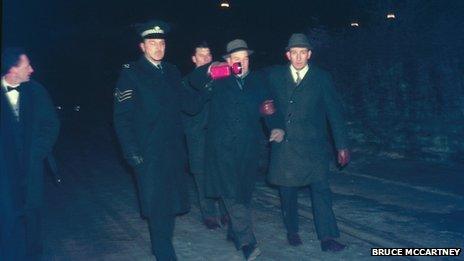
Local minister the Reverend Brydon Maben was arrested after protesters blocked the passage of the last train at Newcastleton level crossing
He adds: "It was freezing cold as it was well past midnight in early January but they were minded not to go and police arrested the parish minister, the Reverend Brydon Maben, who was one of the ringleaders of the demonstration, and that made things even more irresolute.
"The police tried to force the gates open but they could not do anything and eventually I came to an agreement with the crowd that if I could get the minister released from the police station without charges they would go away."
Lord Steel says: "I think it is the only case of where the Edinburgh-London train was held up by the populous. It shows the level of anger and determination they had."
More than 40 years after the closure, some of the Waverley Route is to be revived in the form of the new £300m Borders railway, which, after years of wrangling, is set to be completed by the summer of 2015.
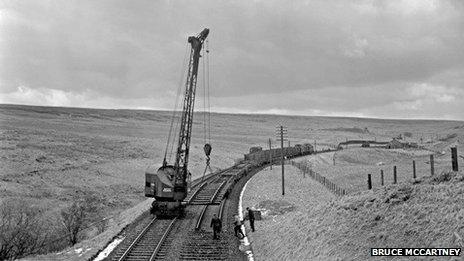
Contractors lift a section of track near Whitrope in late 1969
The new 35-mile line will run from Waverley station in central Edinburgh as far as Galashiels and then to Tweedbank where there will be a park and ride which is designed to give access to the network to people from surrounding towns.
Mr Spaven says: "We have to recognise the achievement of getting the railway back to Galashiels and Tweedbank.
"It will be the longest rail route reopening in modern British history.
"It is an amazing achievement and will take the rail route back to what is now the largest town in the Borders."
Mr Jamieson says: "You can see that car drivers would find it attractive to drive to Tweedbank to use the train then they do not have the stress of driving in to Edinburgh and finding a parking spot."
Lord Steel says the new Borders rail plan is very similar to the one he proposed in the 1960s and it would have been much cheaper if they had not removed the track.
He says: "I think it will increase the amount of commuter travel to Edinburgh.
"The Borders is a very attractive place to live but employment is limited and a lot of people work in Edinburgh and more will do so once they see a railway coming into the city."
Lord Steel, who still lives in the area, also hopes the rail line will improve tourism and thinks Tweedbank station should be renamed Abbotsford to mark its proximity to the former home of Scottish writer Sir Walter Scott.
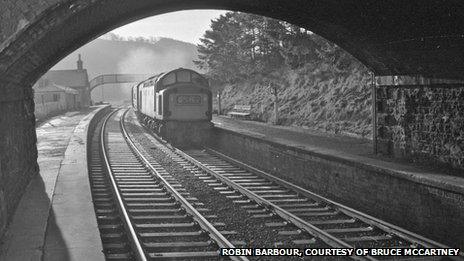
The 09:20 Carlisle-Edinburgh service non-stop through Stow in December 1968
Following the success of the Borders railway campaign and the reinstatement of rail routes to Alloa, Larkhall and the Airdrie-Bathgate line, sustainable transport group Transform Scotland has called on the Scottish government to plug other "missing links" in the rail network.
Mr Spaven says: "Once the Borders railway is reopened the towns which will inherit the unwanted mantle of being the farthest towns of their size from the British railway network will be Fraserburgh and Peterhead in Buchan, north of Aberdeen.
"Two very significant towns which lost their trains in 1965 and there's now the beginnings of a campaign to get part at least of these lines reopened."
He adds: "I think Scotland suffered particularly in the Beeching era from the loss of some important quite long-distance routes which could have fulfilled a more strategic role than perhaps they did at the time.
"The Dumfries-Stranraer line certainly fell into that category.
"It could have been a crucial freight line because it would have allowed freight to the port of Stranraer to develop rather better than it did subsequently."

Steam freight trains wait at Hawick in the summer of 1964.
Local Galloway historian Alistair Livingston says there was some justification for the closure of the line through south west Scotland.
It had been built in Victorian times and took the most direct route to the coast, missing out many of the local towns, he says.
However, he adds: "Since the railway line was closed in 1965 a huge volume of traffic has built up to serve the roll-on roll-off ferries at Stranraer and the main A75 road has had to be upgraded several times in order to cope with it."
There were a number of lines which escaped the Beeching axe despite being recommended for closure.
The 168-mile Inverness-Wick/Thurso line and the 64-mile Inverness-Kyle of Lochalsh route stayed open along with the 76-mile Ayr-Stranraer line.
Part of the reason for retaining the Ayr-Stranraer line was a compromise to keep politicians and businessmen in Northern Ireland happy, says Mr Livingston.
He says that closing the Dumfries to Stranraer and the Ayr to Stranraer line meant that the sleeper service from Belfast to London, via the port of Stranraer, would no longer run.
"Eventually a compromise was reached and they agreed the sleeper trains would be diverted from Dumfries up and round to Ayr to keep the service to Stranraer."
- Published27 March 2013
- Published6 November 2012
- Published6 November 2012
- Published8 April 2012